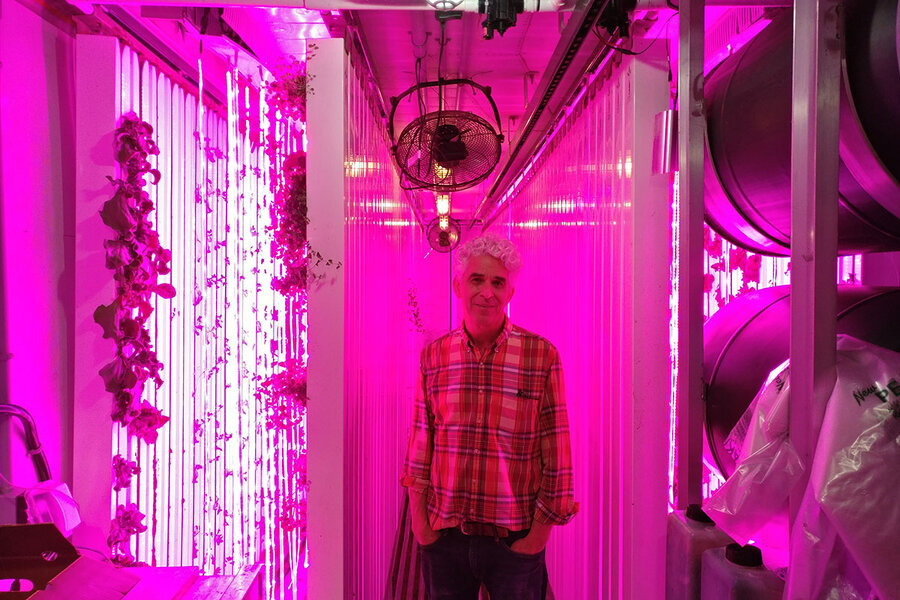Urban farming 2.0: From plow beams to Leafy Green Machines
Loading...
| Boston
Shawn Cooney swings open the door of a 320-square-foot industrial shipping container to reveal a futuristic setting: hundreds of edible plants growing in vertical columns, fed by the energy from strings of neon red and blue LED lights. Nutrient-infused water cascades from ceiling spigots down through artificial root systems in the growing towers. The temperature inside feels like a comfortable spring day – about 70 degrees F., with a touch of humidity. There isn’t a speck of dirt anywhere.
Welcome to the new urban farm.
This shipping container is one of four that comprise Corner Stalk Farm run by Mr. Cooney and his wife in the heart of Boston. Once the cargo holds for exhaust-spewing 18-wheelers, these discarded freight vessels have been transformed into units known as Leafy Green Machines outfitted with state-of-the-art growing technology by a company called Freight Farms. Now they help farmers turn out crops of lettuce and herbs at a rapid pace.
In the past, urban farmers have eked a living from food grown in greenhouses, reclaimed brownfields, vacant lots, or rooftop farms. But with these new kinds of urban crops – grown using what’s known as controlled-environment agriculture, or CEA – farmers leverage technology to break free from the seasonal and climatic limitations that bind traditional crops. As a result, these farmers enjoy longer growing seasons and more plentiful harvests – a hopeful promise for urban communities looking to boost access to fresh produce.
“To think that you don’t have to worry about whether it’s going to rain, or whether the sun is too bright because you flick a switch and you know how much light you have, you know how much water is being supplied ... that would take a lot of the stress out of agriculture,” says Joel Gruver, associate professor and director of Western Illinois University's organic research and demonstration farm.
Getting fresh food into urban centers has proved to be a persistent and growing problem. By 2050, 66 percent of the world’s more than 9 billion people will live in cities, predicts the United Nations. While some cities offer farmers’ markets and have worked to open more grocery stores in so-called food deserts, these farmer-entrepreneurs are searching for solutions that will not only grow fresh food within city limits but also mitigate some of the environmental effects of traditional farming.
“People want real food. And increasingly people live in the city. So there has been – unsurprisingly – a lot of innovation and investment in urban farming in the last handful of years,” says Tobias Peggs, co-founder and chief executive officer of Square Roots Urban Growers in Brooklyn, N.Y. Upon launching, the company received more than 500 applicants for 10 farmer slots from those wanting to take up the challenge.
Easing an environmental burden
Small-scale sustainable farming and organic practices have long sought to lessen the environmental impacts of monocropping and pesticide reliance, but CEA has a significant advantage: the ability to scale up without significantly increasing its ecological footprint. The vertical farming market is expected to quadruple from its $1.5 billion market value in 2016 to $6.4 billion in 2023, according to a recent report by Allied Market Research.
In San Francisco, agrotech company Plenty boasts a 51,000-square-foot warehouse that leverages machine learning to optimize plant growth.
Nate Storey, Plenty’s co-founder and chief science officer, says the environmental benefits gained by fusing technology and food production make large-scale CEA a no-brainer.
“We have no runoff, we have no erosion, we have few, if any, pests, we don’t need to use many of the pesticides, we don’t have any soil to sterilize, we don’t have any intensive irrigation, we use a fraction of the water,” he explains. “There are just not a whole lot of reasons not to do this.”
Unlike other large-scale food producers who must optimize their goods for long truck rides and shelf lives, indoor growers located closer to customers can instead prioritize food quality, such as flavor and “mouth feel,” as Dr. Storey puts it.
For independent CEA farmers, starting up a controlled environment for indoor growing doesn’t come cheap. A Freight Farms unit costs $85,000 and the annual operating costs range between $8,000 and $16,500. But Cooney of Corner Stalk Farm, who bases the size of his crop on customer demand, explains that similarly sized outdoor farms are pressured to overproduce during short growing seasons.
“Their losses are much higher. So that’s why it comes out to be about the same,” he says. Moreover, other farms may spend a fortune on transportation and land. Taking up about 1/34th of an acre, Cooney’s lettuce farm can have a marketable yield that’s about the equivalent of 8 acres of traditional farmland yield, according to Freight Farms. And the indoor environment allows for a continual harvest.
But without the government subsidies that larger farms growing subsidized commodity crops receive, greens grown within shipping containers will inevitably cost more than most supermarket greens.
“A bag of our Square Roots greens costs about as much as a Starbucks [coffee],” admits Mr. Peggs. He is quick to add that the enhanced sense of community fostered through farmer-customer relationships makes the price worthwhile.
“Customers come to the farm and hangout – we have a big window on the farm, so everyone can see what’s going on. It’s all about total transparency in the food-supply chain,” Peggs says.
But is high-tech food ‘natural’?
The benefits of CEA may be tantalizing, but Dr. Gruver of Western Illinois University foresees potential difficulties for the burgeoning industry. Controlled-environment agriculture depends upon those who can operate and fix the technology. In other words, finding someone who can troubleshoot a malfunctioning LED system may prove more difficult than finding someone who can repair a tractor, for example.
And while local food and connections to the farmers who grow it have proven to be profitable in urban markets, not everyone embraces the idea of food grown exclusively in an artificial environment.
“I think with any high-tech approach, there is a general concern that it’s not natural,” says Gruver. “There’s more potential for unforeseen, unintended consequences.”
Urban tech growers are well aware of this perception.
“We’re sensitive to that,” responds Storey of Plenty. “We’re really focused on how do we show people that this new growing environment is something that is important for our food supply.”
Before indoor farmers can dominate the urban food arena, however, they’ll need to grow more than lettuce and herbs. The larger the plant, the more energy it costs to grow it, and this energy is currently expensive.
But based on the rapid pace of innovation and technology, Peggs predicts large, affordable produce may not be far off. He thinks his Square Roots entrepreneurs will figure out how to grow sustainable strawberries within 18 months.
“Imagine a farmer traipsing through 2 feet of snow to deliver you a box of freshly harvested, locally grown strawberries in the middle of a New York winter,” he says. “In the near future everyone will have local food and they will know your farmer.”






